TOYOTA LAND CRUISER 2001 Service Manual
Manufacturer: TOYOTA, Model Year: 2001, Model line: LAND CRUISER, Model: TOYOTA LAND CRUISER 2001Pages: 142, PDF Size: 2.96 MB
Page 41 of 142

’01 L/C U (L/O 0008)121
Use the center differential lock system if
your wheels get stuck in a ditch, or when
you are driving on a slippery or bumpy
surface. When the center differential is
locked, the vehicle skid control system is
automatically turned off and the center dif-
ferential lock and “VSC OFF” indicator
lights come on because the function that
controls engine performance interferes
with the process of freeing your wheels.
NOTICE
As soon as the center differential lock
switch is turned on, the “VSC OFF”
indicator light comes on. After the
wheels are out of the ditch or off the
slippery or bumpy surface, turn the
center differential lock switch off.
Make sure the center differential lock
indicator light and vehicle skid con-
trol system off indicator light turn off.
“H” (high speed position, center differ-
ential unlocked):
Lever at “H”, center dif-
ferential lock button left out
Use this for normal driving on all types of
roads, from dry hard −surfaced roads to
wet, icy or snow −covered roads. This
position gives greater economy, quietest
ride, least wear and better vehicle control. “H” (high speed position, center differ-
ential locked):
Lever at “H”, center differ-
ential lock button pushed in
Use this for greater traction when you
experience a loss of power, such as
wheel slipping, in the center differential
unlock mode.
“N” (neutral position): Lever at “N”
No power is delivered to the wheels. The
vehicle must be stopped.
“L” (low speed position, center differen-
tial unlocked): Lever at “L”, center differ-
ential lock button left out
Use this for maximum power and traction.
Use this for climbing or descending steep
hills, off −road driving, and hard pulling in
sand or mud.
In this mode, the braking feeling that oc-
curs when the wheels are negotiating a
sharp corner is further reduced than in the
“L” (low position, center differential locked)
mode. “L” (low speed position, center differen-
tial locked):
Lever at “L”, center differen-
tial lock button pushed in.
Use this for maximum power and traction.
Use this for hard pulling in situations the
vehicle cannot negotiate even in the “L”
(low speed position, center differential un −
locked) mode. Also, using this mode when
driving down steep off −road inclines will
help contribute to increased vehicle stabil-
ity.
The indicator light tells when the differen-
tial lock is engaged. Note that the differ-
ential is not still locked as long as the
indicator light remains off.
If the indicator light does not go off when
you push out the center differential lock
button, drive straight ahead while acceler-
ating or decelerating, or drive in reverse.
See “(b) Shifting procedure” for further in-
structions.
Page 42 of 142
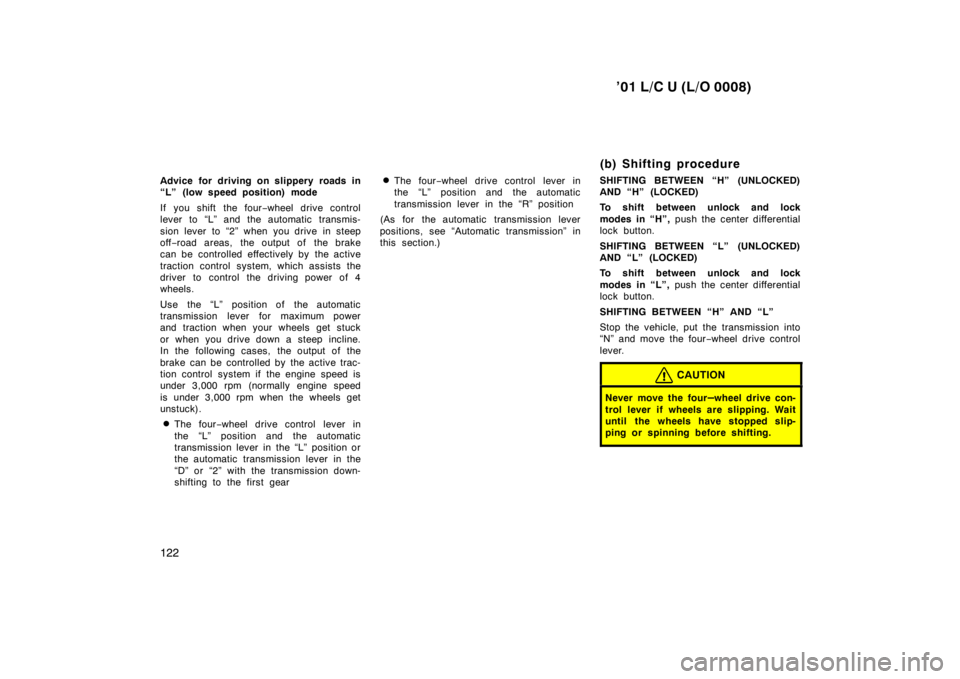
’01 L/C U (L/O 0008)
122
Advice for driving on slippery roads in
“L” (low speed position) mode
If you shift the four
−wheel drive control
lever to “L” and the automatic transmis-
sion lever to “2” when you drive in steep
off −road areas, the output of the brake
can be controlled effectively by the active
traction control system, which assists the
driver to control the driving power of 4
wheels.
Use the “L” position of the automatic
transmission lever for maximum power
and traction when your wheels get stuck
or when you drive down a steep incline.
In the following cases, the output of the
brake can be controlled by the active trac-
tion control system if the engine speed is
under 3,000 rpm (normally engine speed
is under 3,000 rpm when the wheels get
unstuck).
� The four −wheel drive control lever in
the “L” position and the automatic
transmission lever in the “L” position or
the automatic transmission lever in the
“D” or “2” with the transmission down-
shifting to the first gear �
The four −wheel drive control lever in
the “L” position and the automatic
transmission lever in the “R” position
(As for the automatic transmission lever
positions, see “Automatic transmission” in
this section.) (b) Shifting procedure
SHIFTING BETWEEN “H” (UNLOCKED)
AND “H” (LOCKED)
To shift between unlock and lock
modes in “H”,
push the center differential
lock button.
SHIFTING BETWEEN “L” (UNLOCKED)
AND “L” (LOCKED)
To shift between unlock and lock
modes in “L”, push the center differential
lock button.
SHIFTING BETWEEN “H” AND “L”
Stop the vehicle, put the transmission into
“N” and move the four −wheel drive control
lever.
CAUTION
Never move the four –wheel drive con-
trol lever if wheels are slipping. Wait
until the wheels have stopped slip-
ping or spinning before shifting.
Page 43 of 142

’01 L/C U (L/O 0008)123
Parking brake
When parking, firmly apply the parking
brake to avoid inadvertent creeping.
To set: Pull up the lever. For better hold-
ing power, first depress the brake pedal
and hold it while setting the parking
brake.
To release: Pull up the lever slightly (1),
press the lock release button (2), and low-
er (3).
To remind you that the parking brake is
set, the parking brake reminder light in
the instrument panel remains on until you
release the parking brake.
CAUTION
Before driving, be sure the parking
brake is fully released and the park-
ing brake reminder light is off.
Cruise control
The cruise control allows you to cruise
the vehicle at a desired speed over 40
km/h (25 mph) even with your foot off
the accelerator pedal.
Your cruising speed can be maintained up
or down grades within the limits of engine
performance, although a slight speed
change may occur when driving up or
down the grades. On steeper hills, a
greater speed change will occur so it is
better to drive without the cruise control.
When the cruise control is on, the driving
pattern of the automatic transmission is
fixed in the normal position, regardless of
the position of the driving pattern selector
switch.
Page 44 of 142
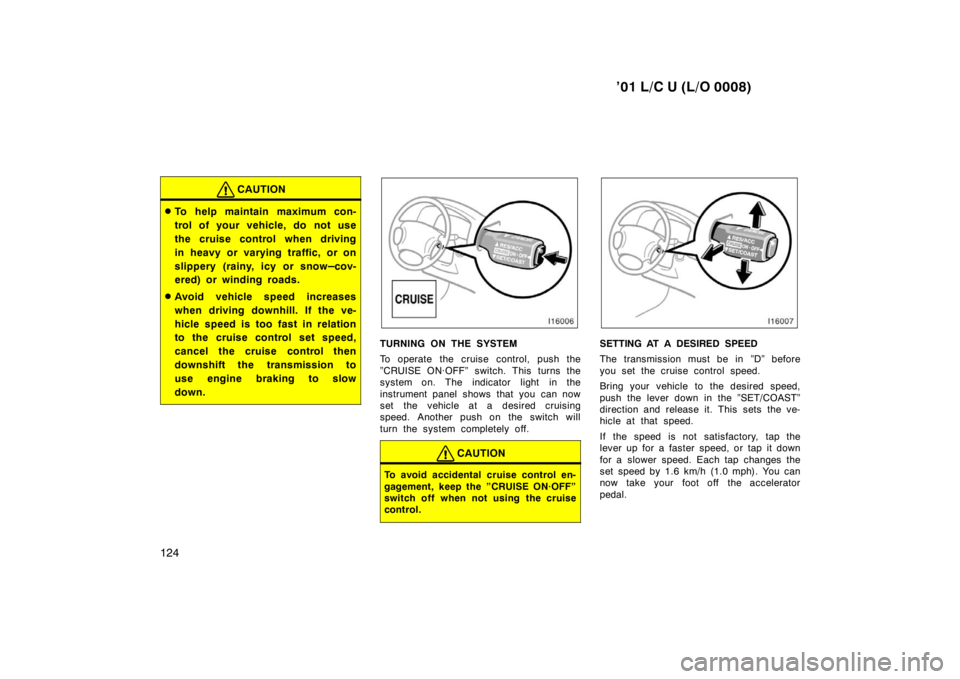
’01 L/C U (L/O 0008)
124
CAUTION
� To help maintain maximum con-
trol of your vehicle, do not use
the cruise control when driving
in heavy or varying traffic, or on
slippery (rainy, icy or snow
–cov-
ered) or winding roads.
� Avoid vehicle speed increases
when driving downhill. If the ve-
hicle speed is too fast in relation
to the cruise control set speed,
cancel the cruise control then
downshift the transmission to
use engine braking to slow
down.
TURNING ON THE SYSTEM
To operate the cruise control, push the
”CRUISE ON·OFF” switch. This turns the
system on. The indicator light in the
instrument panel shows that you can now
set the vehicle at a desired cruising
speed. Another push on the switch will
turn the system completely off.
CAUTION
To avoid accidental cruise control en-
gagement, keep the ”CRUISE ON·OFF”
switch off when not using the cruise
control.
SETTING AT A DESIRED SPEED
The transmission must be in ”D” before
you set the cruise control speed.
Bring your vehicle to the desired speed,
push the lever down in the ”SET/COAST”
direction and release it. This sets the ve-
hicle at that speed.
If the speed is not satisfactory, tap the
lever up for a faster speed, or tap it down
for a slower speed. Each tap changes the
set speed by 1.6 km/h (1.0 mph). You can
now take your foot off the accelerator
pedal.
Page 45 of 142

’01 L/C U (L/O 0008)125
If you need acceleration—for example,
when passing—depress the accelerator
pedal enough for the vehicle to exceed
the set speed. When you release it, the
vehicle will return to the speed set prior
to the acceleration.
CANCELLING THE PRESET SPEED
You can cancel the preset speed by:
a. Pulling the control lever in the ”CANCEL” direction and releasing it.
b. Depressing the brake pedal.
If the vehicle speed falls below about 40
km/h (25 mph), the preset speed will auto-
matically cancel out.
If the vehicle speed drops 16 km/h (10
mph) below the preset speed, the preset
speed will also automatically cancel out.
If the preset speed automatically cancels
out other than for the above cases, have
your vehicle checked by your Toyota deal-
er at the earliest opportunity. RESETTING TO A FASTER SPEED
Push the lever up in the ”RES/ACC” direc-
tion and hold it. Release the lever when
the desired speed is attained. While the
lever is held up, the vehicle will gradually
gain speed.
However, a faster way to reset is to ac-
celerate the vehicle and then push the
control lever down in the ”SET/COAST”
direction.
RESETTING TO A SLOWER SPEED
Push the lever down in the ”SET/COAST”
direction and hold it. Release the lever
when the desired speed is attained. While
the lever is held down, the vehicle speed
will gradually decrease.
However, a faster way to reset is to de-
press the brake pedal and then push the
control lever down in the ”SET/COAST”
direction.
Even if you downshift the transmission by
turning off the overdrive switch, with the
cruise control on, engine braking will not
be applied because the cruise control is
not cancelled. To decrease the vehicle
speed, reset to a slower speed with the
cruise control lever or depress the brake
pedal. If you use the brake pedal, cruise
control is cancelled.RESUMING THE PRESET SPEED
If the preset speed is cancelled by pulling
the control lever or by depressing the
brake pedal, pushing the lever up in the
”RES/ACC” direction will restore the speed
set prior to cancellation.
However, once the vehicle speed falls be-
low about 40 km/h (25 mph), the preset
speed will not be resumed.
CRUISE CONTROL FAILURE WARNING
If the ”CRUISE” indicator light in the
instrument cluster flashes when using the
cruise control, press the ”CRUISE
ON·OFF” button to turn the system off and
then press it again to turn it on.
If any of the following conditions then oc-
curs, there is some trouble in the cruise
control system.
� The indicator light does not come on.
� The indicator light flashes again.
� The indicator light goes out after it
comes on.
If this is the case, contact your Toyota
dealer and have your vehicle inspected.
Page 46 of 142
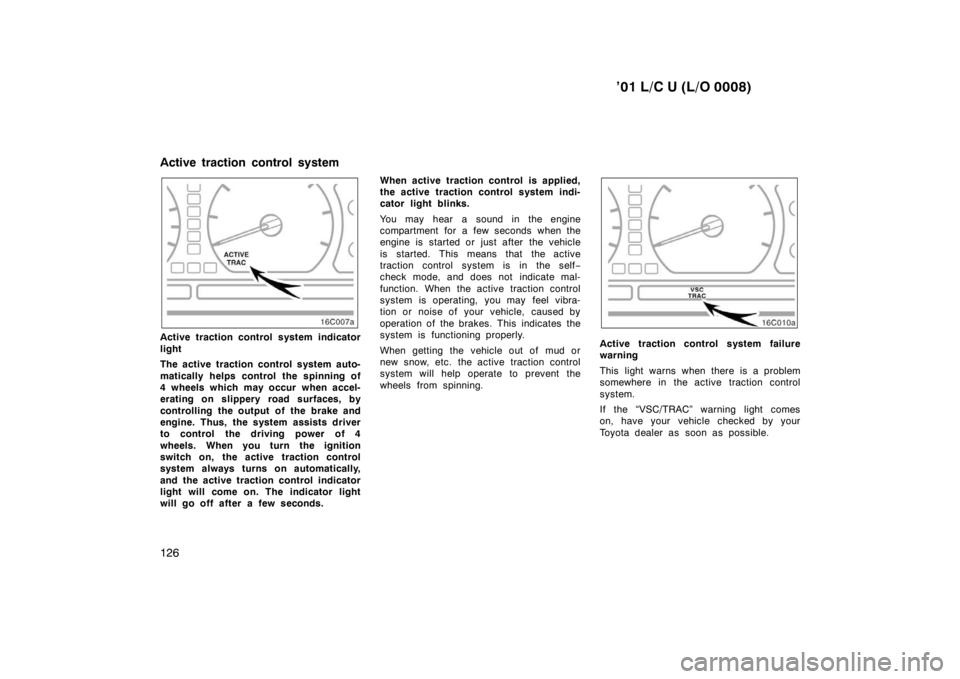
’01 L/C U (L/O 0008)
126
Active traction control system indicator
light
The active traction control system auto-
matically helps control the spinning of
4 wheels which may occur when accel-
erating on slippery road surfaces, by
controlling the output of the brake and
engine. Thus, the system assists driver
to control the driving power of 4
wheels. When you turn the ignition
switch on, the active traction control
system always turns on automatically,
and the active traction control indicator
light will come on. The indicator light
will go off after a few seconds. When active traction control is applied,
the active traction control system indi-
cator light blinks.
You may hear a sound in the engine
compartment for a few seconds when the
engine is started or just after the vehicle
is started. This means that the active
traction control system is in the self
−
check mode, and does not indicate mal-
function. When the active traction control
system is operating, you may feel vibra-
tion or noise of your vehicle, caused by
operation of the brakes. This indicates the
system is functioning properly.
When getting the vehicle out of mud or
new snow, etc. the active traction control
system will help operate to prevent the
wheels from spinning.Active traction control system failure
warning
This light warns when there is a problem
somewhere in the active traction control
system.
If the “VSC/TRAC” warning light comes
on, have your vehicle checked by your
Toyota dealer as soon as possible.
Active traction control system
Page 47 of 142
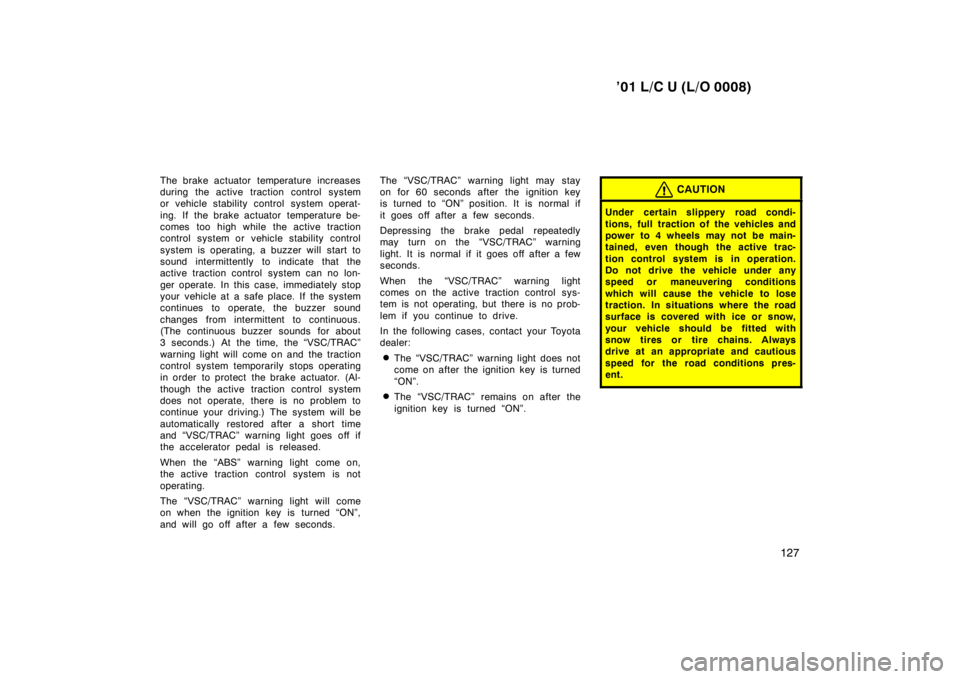
’01 L/C U (L/O 0008)127
The brake actuator temperature increases
during the active traction control system
or vehicle stability control system operat-
ing. If the brake actuator temperature be-
comes too high while the active traction
control system or vehicle stability control
system is operating, a buzzer will start to
sound intermittently to indicate that the
active traction control system can no lon-
ger operate. In this case, immediately stop
your vehicle at a safe place. If the system
continues to operate, the buzzer sound
changes from intermittent to continuous.
(The continuous buzzer sounds for about
3 seconds.) At the time, the “VSC/TRAC”
warning light will come on and the traction
control system temporarily stops operating
in order to protect the brake actuator. (Al-
though the active traction control system
does not operate, there is no problem to
continue your driving.) The system will be
automatically restored after a short time
and “VSC/TRAC” warning light goes off if
the accelerator pedal is released.
When the “ABS” warning light come on,
the active traction control system is not
operating.
The “VSC/TRAC” warning light will come
on when the ignition key is turned “ON”,
and will go off after a few seconds.
The “VSC/TRAC” warning light may stay
on for 60 seconds after the ignition key
is turned to “ON” position. It is normal if
it goes off after a few seconds.
Depressing the brake pedal repeatedly
may turn on the “VSC/TRAC” warning
light. It is normal if it goes off after a few
seconds.
When the “VSC/TRAC” warning light
comes on the active traction control sys-
tem is not operating, but there is no prob-
lem if you continue to drive.
In the following cases, contact your Toyota
dealer:
� The “VSC/TRAC” warning light does not
come on after the ignition key is turned
“ON”.
� The “VSC/TRAC” remains on after the
ignition key is turned “ON”.
CAUTION
Under certain slippery road condi-
tions, full traction of the vehicles and
power to 4 wheels may not be main-
tained, even though the active trac-
tion control system is in operation.
Do not drive the vehicle under any
speed or maneuvering conditions
which will cause the vehicle to lose
traction. In situations where the road
surface is covered with ice or snow,
your vehicle should be fitted with
snow tires or tire chains. Always
drive at an appropriate and cautious
speed for the road conditions pres-
ent.
Page 48 of 142
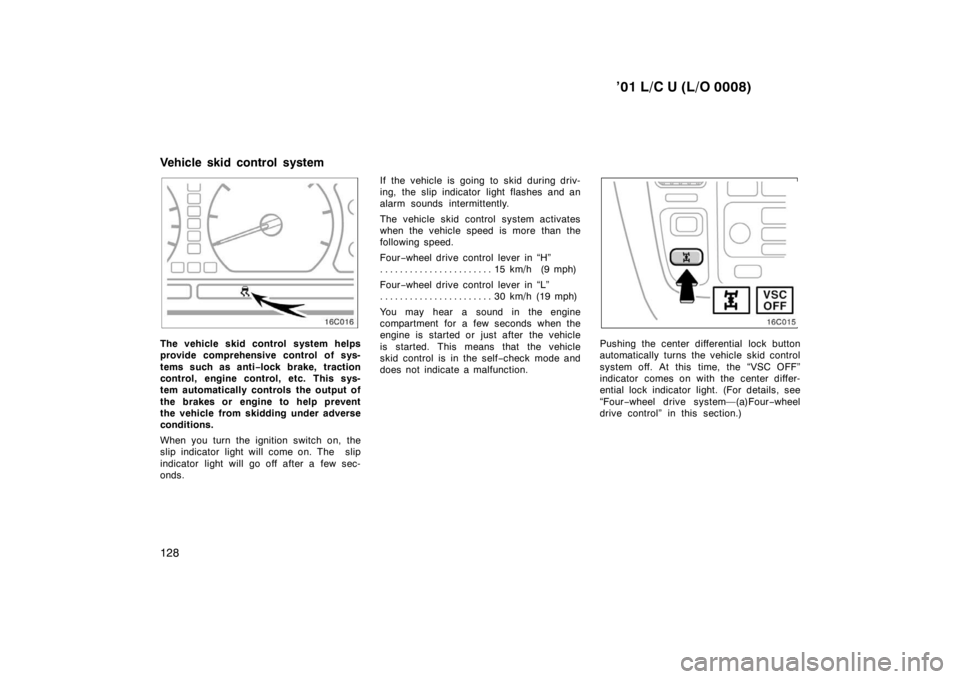
’01 L/C U (L/O 0008)
128
The vehicle skid control system helps
provide comprehensive control of sys-
tems such as anti −lock brake, traction
control, engine control, etc. This sys-
tem automatically controls the output of
the brakes or engine to help prevent
the vehicle from skidding under adverse
conditions.
When you turn the ignition switch on, the
slip indicator light will come on. The slip
indicator light will go off after a few sec-
onds. If the vehicle is going to skid during driv-
ing, the slip indicator light flashes and an
alarm sounds intermittently.
The vehicle skid control system activates
when the vehicle speed is more than the
following speed. Four
−wheel drive control lever in “H”
15 km/h (9 mph)
. . . . . . . . . . . . . . . . . . . . . . . Four −wheel drive control lever in “L”
30 km/h (19 mph)
. . . . . . . . . . . . . . . . . . . . . . .
You may hear a sound in the engine
compartment for a few seconds when the
engine is started or just after the vehicle
is started. This means that the vehicle
skid control is in the self −check mode and
does not indicate a malfunction.Pushing the center differential lock button
automatically turns the vehicle skid control
system off. At this time, the “VSC OFF”
indicator comes on with the center differ-
ential lock indicator light. (For details, see
“Four −wheel drive system—(a)Four −wheel
drive control” in this section.)
Vehicle skid control system
Page 49 of 142
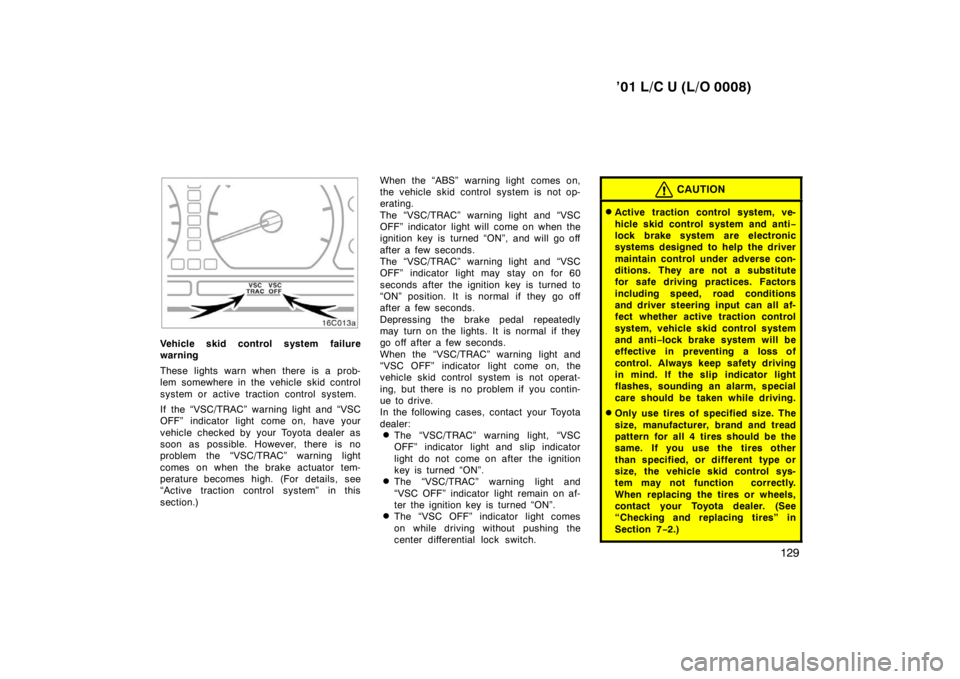
’01 L/C U (L/O 0008)129
Vehicle skid control system failure
warning
These lights warn when there is a prob-
lem somewhere in the vehicle skid control
system or active traction control system.
If the “VSC/TRAC” warning light and “VSC
OFF” indicator light come on, have your
vehicle checked by your Toyota dealer as
soon as possible. However, there is no
problem the “VSC/TRAC” warning light
comes on when the brake actuator tem-
perature becomes high. (For details, see
“Active traction control system” in this
section.) When the “ABS” warning light comes on,
the vehicle skid control system is not op-
erating.
The “VSC/TRAC” warning light and “VSC
OFF” indicator light will come on when the
ignition key is turned “ON”, and will go off
after a few seconds.
The “VSC/TRAC” warning light and “VSC
OFF” indicator light may stay on for 60
seconds after the ignition key is turned to
“ON” position. It is normal if they go off
after a few seconds.
Depressing the brake pedal repeatedly
may turn on the lights. It is normal if they
go off after a few seconds.
When the “VSC/TRAC” warning light and
“VSC OFF” indicator light come on, the
vehicle skid control system is not operat-
ing, but there is no problem if you contin-
ue to drive.
In the following cases, contact your Toyota
dealer:
� The “VSC/TRAC” warning light, “VSC
OFF” indicator light and slip indicator
light do not come on after the ignition
key is turned “ON”.
� The “VSC/TRAC” warning light and
“VSC OFF” indicator light remain on af-
ter the ignition key is turned “ON”.
� The “VSC OFF” indicator light comes
on while driving without pushing the
center differential lock switch.
CAUTION
�Active traction control system, ve-
hicle skid control system and anti −
lock brake system are electronic
systems designed to help the driver
maintain control under adverse con-
ditions. They are not a substitute
for safe driving practices. Factors
including speed, road conditions
and driver steering input can all af-
fect whether active traction control
system, vehicle skid control system
and anti −lock brake system will be
effective in preventing a loss of
control. Always keep safety driving
in mind. If the slip indicator light
flashes, sounding an alarm, special
care should be taken while driving.
� Only use tires of specified size. The
size, manufacturer, brand and tread
pattern for all 4 tires should be the
same. If you use the tires other
than specified, or different type or
size, the vehicle skid control sys-
tem may not function correctly.
When replacing the tires or wheels,
contact your Toyota dealer. (See
“Checking and replacing tires” in
Section 7 −2.)
Page 50 of 142

’01 L/C U (L/O 0008)
130 OPERATION OF INSTRUMENTS AND
CONTROLS
Car audio system
Reference131
. . . . . . . . . . . . . . . . . . . . . . . . . . . . . . . . . . . . . . . . . . . . . . . . .
Using your audio system131
. . . . . . . . . . . . . . . . . . . . . . . . . . . . . . . . . . . .
Car audio system operating hints140
. . . . . . . . . . . . . . . . . . . . . . . . . . . . .
For vehicle equipped with Navigation system, please refer to the
separate “Owner’s Manual for Navigation System”.
SECTION 1− 7